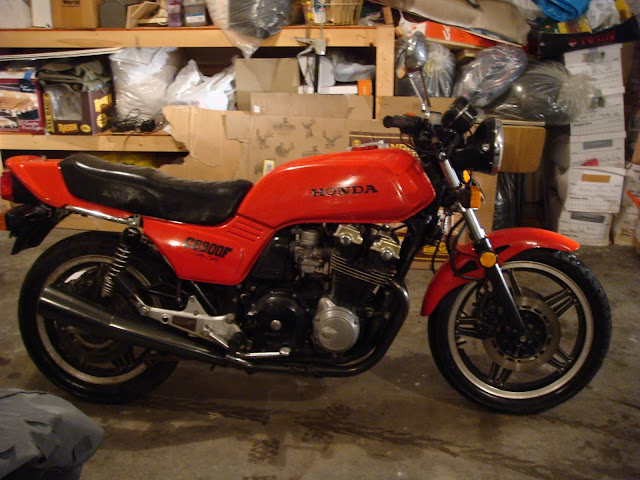Honda CB900F
Despite being designed as a sports bike, the CB900F's slightly raised handlebars gave a fairly upright riding position that soon became tiring at anything close to the bike’s top speed.
The 900F’s 'Eurostyle'shape was attractive and quite sporty, although it was reminiscent of other Hondas. These included not only the CB750FZ that was launched simultaneously, but also small-capacity Super Dream twins.
The arrival of the CB900F in 1979 marked an important upturn in Honda’s superbike fortunes. At that time, the world’s biggest bike firm badly needed a high- performance machine to compete with Kawasaki's ever-popular Z1000 and Suzuki’s GS1000. Honda’s single-cam CB750 had long been outclassed by bigger dohc fours, and the previous year’s six- cylinder CBX1000 had not been a success despite its power and panache.
The more conventional 900F four pitched Honda straight into the hard-fought superbike battle, backed by a big promotional campaign based on its race-developed technology. ‘It’s a powerhouse that has evolved directly from our all- conquering Endurance RCB machine,’ ran the advertising line. ‘A thundering Super Sports bike with devastating performance and unwavering stamina that will be setting the pace for many years to come.’
The hype and racing references were largely justified. Honda’s mighty lOOOcc RCB fours had dominated European endurance racing, notably in the hands of French duo Christian Leon and Jean-Claude Chemarin.
(In 1978 RCBs took the first three places in the prestigious Bol d'Or 24 hour race and won a third consecutive Coupe d’Endurance championship.) The CB900F was no race-replica, but the roadster’s development had clearly been influenced by the RCB.
Honda s first dohc roadgoing four had long- stroke dimensions and a capacity of 901 cc. The aircooled unit held 16 valves and produced 95bhp Kith plenty of mid-range torque. It was conventional in design, api. two came hauo from crankshaft to exhaust cam, the second from exhaust to inlet.
The steel-framed twin-shock chassis provided good handling, especially when fitted with aftermarket rear shock units, like this hike whose original FVQ units have been replaced by Konis. The wheels were Honda's composite Comstar design.
Styled for Europe
In contrast to most previous Japanese superbikes, which had been designed with the American market in mind, the 900F was aimed at Europe, and initially was not even sold in the States. Its angular Eurostyle shape, with fuel tank blending into sidepanels, was pleasant in an understated way. Indeed the 900F, with its twin silencers, looked very similar to Honda’s humble CB400 Super Dream - a fact that did the bigger model no favours.
The 90lcc engine was the bike’s star attraction. Along with the CB750FZ that was launched at the same time, the 900F finally gave Honda a big twin- cam powerplant, six years after the arrival of Kawasaki’s Zl. The 16-valve unit had fairly long- stroke dimensions of 64.5 x 69mm. and produced a claimed maximum of 95bhp at 9000rpm.
Despite its racing heritage and sporty image, the 900F was tuned for mid-range rather than ultimate power. It delivered arm-stretching acceleration from 4000rpm in top gear to the 9500rpm redline. At 90mph (I45km/h) the motor’s slight high-frequency vibration made it feel rather busy. But the leant-forward riding position and broad seat made the Honda comfortable at most speeds, if not at the bike’s maximum of over I30mph (210km/h).
The 900F’s chassis was arguably the best Honda had built for the street. There was nothing obviously special about the frame, with its top spine of three steel tubes. But it was very strong, and equipped with high quality suspension. The front forks were air-assisted, and the rear shocks were adjustable for compression and rebound damping, as well as spring preload.\
Despite the Honda’s 5l4lb (233kg) of weight, it handled well and had enough ground clearance to make fast cornering fun. Stopping power was less impressive, and braking was one of the things uprated in 1982, when a revised 900F appeared boasting twin-piston front calipers plus Honda’s new TRAC anti-dive system. There was also the option of a full fairing, with which the bike was called the CB900 F2B (standing, some said, for ‘Far 2 Big’).
The unfaired CB900F remained in production for several more years, and also formed the basis of the exotic CBl 100R production racer. Back in 1979 one tester had described the original twin-cam four as ‘the nearest any manufacturer has come to producing the Perfect Motorcycle'. That might have been an exaggeration, but the CB900F had certainly put Honda’s superbike range back on the right track.
Specification Honda CB900F (1979)
- Engine Air-cooled dohc 16-valve transverse four
- Capacity 901 cc (64.5 x 69mm)
- Maximum power 95bhp @ 9000rpm
- Transmission Five-speed, chain final drive
- Frame Steel twin downtube
- Suspension Telescopic front; twin shocks rear
- Brakes Twin discs front; disc rear
- Weight 5141b (233kg)
- Top speed 135mph (217km/h)
























0 comments: